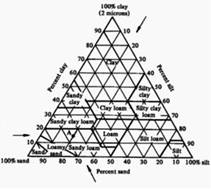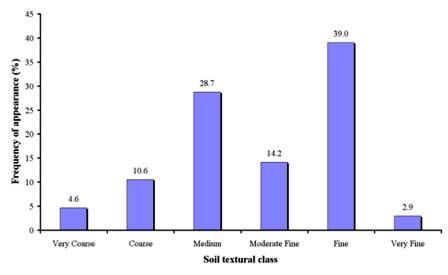Soil texture
Soil texture is the relative proportion of sand, silt, and clay in a soil. Sand, silt and clay are the 2.0 to 0.05, the 0.05 to 0.002 and the less than 0.002 mm soil fractions, respectively. Soil texture greatly affects soil drainage, water holding capacity, soil temperature, soil erosion as well as fertility and plant productivity. Clay holds more water available for plant growth than sandy soils and the presence of water considerably modifies the heat requirements of the soil. Clay soils have poor drainage of excess water and may become waterlogged. Soil texture affects soil resistance to erosion. The coarser the soil texture, the smaller the active surface area of the soil particles, and the smaller is the resistance of the soil to erosion. Soils containing high amount of silt, such as those formed on marl deposits, are sensitive to crust formation generating high surface water runoff and sediment loss.
Soils have been classified according to their texture in classes, and each textural class had a given range of sand, silt and clay. The following 12 classes were designated: Sand (S), loamy sand (LS), sandy loam (SL), loam, (L), silt loam (SiL), silt (Si), clay loam (CL), sandy clay loam (SCL), silty clay loam (SiCL), clay (C), silty clay (SiC), and sandy clay (SC) (Fig 24). Four broad groups of classes are recognized: Sands, Silts, Clays and Loams. Sands contain at least 80% sand particles and 15% or less clay particles by weight. Silts contain at least 80% silt and 12% clay particles, respectively. Clays contain at least 35% of clay particles. Loams are mixtures of sand, silt and clay particles that exhibit the properties of those particles in equal proportions. Loam soils have the best combination of physical and chemical properties in terms of cultivation and crop growth.
Soil texture has been estimated in the field through the feel of a moist soil moulded between fingers and thumb. Also soil texture was quantitatively determined in the laboratory using the hydrometer method. The 12 textural classes were further grouped into 6 categories very coarse (S, LS), coarse (SL), medium (L, SiL, and Si), fine (Cl, SCL, and SiCL), fine (C, SiC and SC) and very fine soils having clay content greater than 70%.

Fig. 24. The USDA textural triangle showing the limits of sand, silt and clay contents of the various textural classes
Soil texture has been determined in 1497 field sites, corresponding to 15 study sites (Table 3). The dominant textural classes were fine, covering 39.0% of the study field sites (Fig. 25). Such textural class has been found in all study field sites of Guadalentin Basin Murcia-Spain, and Djanybek-Russia, and in some cases in the rest of study sites except Plateau-China. The following important textural classes were fine, covering 28.7% of the study field sites. Such soil textural classes were found in all study field sites of Loess Plateau-China, and in some study fields of Secano Interior-Chile, Rendina Basin Basilicata-Italy, Nestos Basin Maggana-Greece, Boteti Area-Botswana, Santiago Island-Cape Verde, Mamora Sehoul-Morocco, Zeuss Koutine-Tunisia, Gois-Portugal, Cointzio catchment-Mexico, and Crete-Greece. Moderately fine textural classes were found in 14.2% of the study field sites located mainly in the field sites of Secano Interior-Chile, Nestos Basin Maggana-Greece, Boteti Area-Botswana, Konya Karapinar plain-Turkey, Santiago Island-Cape Verde, Mamora Sehoul-Morocco, Eskisehir-Turkey, Zeuss Koutine-Tunisia, Novij Saratov-Russia, Djanybek-Russia, Gois-Portugal, Cointzio catchment-Mexico, and Crete-Greece. Coarse and very coarse textural classes were found in some cases covering 4.6% and 10.6% of the study field sites, respectively. Such textural classes did not found in the study sites of Secano Interior-Chile, Rendina Basin Basilicata-Italy, Guadalentin Basin Murcia-Spain, Novij Saratov-Russia, Djanybek-Russia, Gois-Portugal, Cointzio catchment-Mexico, and Loess Plateau-China. Very fine textural classes were very limited, covering 2.9% of the study field sites and located in the study sites of Boteti Area-Botswana, Konya Karapinar plain-Turkey, Gois-Portugal, Cointzio catchment-Mexico, and Eskisehir-Turkey.

Fig. 25. Distribution of soil textural classes measured in the study field sites